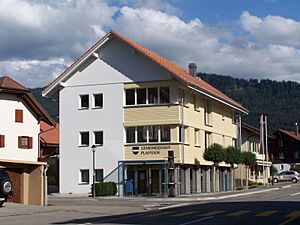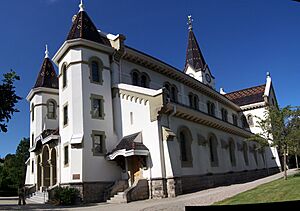Plaffeien facts for kids
Quick facts for kids
Plaffeien
|
||
|---|---|---|

Plaffeien village
|
||
|
||
| Country | Switzerland | |
| Canton | Fribourg | |
| District | Sense | |
| Area | ||
| • Total | 66.53 km2 (25.69 sq mi) | |
| Elevation | 856 m (2,808 ft) | |
| Population
(Dec 2020 )
|
||
| • Total | 3,613 | |
| • Density | 54.306/km2 (140.653/sq mi) | |
| Postal code | ||
| Localities | Schwarzsee | |
| Surrounded by | Brünisried, Giffers, Jaun, Plasselb, Rechthalten, Tafers and Val-de-Charmey in the canton of Fribourg, such as Boltigen, Guggisberg and Oberwil im Simmental in the canton of Bern. | |
| Twin towns | Kasterlee (Belgium) | |
Plaffeien (which is Planfayon in French) is a town in the canton of Fribourg, Switzerland. It is located in the Sense district. Plaffeien is special because most of its people speak German, even though the Fribourg canton mostly speaks French.
Contents
History of Plaffeien
Plaffeien was first written about in 1148. Back then, it was called Planfeiun. Later, in 1339, its name was recorded as Blanfeyen.
What Does the Name Plaffeien Mean?
The name Plaffeien likely comes from an old Latin phrase, "planum-fageum." This means "beech forest." So, the name might have been used since the time of the Romans.
Over time, the spelling of the name changed. In the 13th century, it was Planfeium. Later, it became Plainfaon or Planfeyen. Around the 16th century, it was spelled Plaffeyen. In 1899, a Swiss rule changed the "y" in German place names to an "i," making the official name "Plaffeien."
A Quick Look at Plaffeien's Past
During the Roman times, Plaffeien was probably a village where Romanized Celts lived. Starting around the late 400s, German-speaking people called the Alemanni slowly moved into the area and made it their home.
The first written records about Plaffeien are from a place called Rüeggisberg Priory in 1148. These records mention a church in the village. This church was likely built a few years before. When the church was taken down in 1762, a stone with the year 1143 was found. The village also had a school before 1717.
In the 1300s, a nobleman named Wilhelm von Englisberg gave a forest and shared land to the village. He asked that a special church service be held every year on July 25th to remember him. This service is still held today.
Plaffeien became part of Fribourg in 1486. It stayed under Fribourg's control until 1798, when the French army invaded Switzerland. Plaffeien was on an important road to the Euschelspass and near the Sense river. Because of this, it was invaded several times during wars between Bern and Fribourg. During the Reformation, the village chose to remain Catholic.
The Great Village Fire of 1906
On May 31, 1906, a big fire destroyed much of Plaffeien in about two hours. A total of 51 houses burned down. This included 15 houses in Oberschrot and 36 in Plaffeien. The fire left 62 families, or 274 people, without homes.
People started rebuilding in the summer of 1906. The first stone of the new church was laid on April 26, 1908. A new plan was made for the village, replacing the old village with its narrow, winding streets.
How Plaffeien Grew: Village Mergers
In 2017, two nearby towns, Zumholz and Oberschrot, joined with Plaffeien. They all became one larger municipality called Plaffeien.
Geography and Landscape
After the 2017 merger, Plaffeien covers an area of about 66.53 square kilometers (25.69 square miles).
A large part of Plaffeien's land, about 48.1%, is used for farming. Forests cover 38.1% of the area. About 2.9% of the land has buildings or roads, and 10.9% is unproductive land like mountains.
The village of Plaffeien is located about 12 kilometers (7.5 miles) southeast of Fribourg. The municipality also includes the Muscherenschlund valley, the Schwarzsee valley, and the top of the Schafberg mountain. This mountain is 2,235 meters (7,333 feet) above sea level.
Plaffeien's Coat of Arms
The blazon (official description) of Plaffeien's coat of arms is "Sable a Bar Argent." This means it has a silver bar on a black background.
The new coat of arms has a silver bar on a black background, which was the old symbol for Plaffeien. In the top part, there is a golden lily. This lily represents unity and comes from the old symbols of Oberschrot and Zumholz, the towns that merged with Plaffeien.
Two blue wavy lines on the silver bar stand for the beautiful rivers in the area, the Sense and the Dütschbach. These rivers are important to the area's nature and history.
Population and People
Plaffeien has a population of about 3,600 people. As of 2008, about 6.2% of the people living in Plaffeien were from other countries.
Most people in Plaffeien speak German. In 2000, about 91.5% of the population spoke German as their main language. Albanian was the second most common language, and French was the third.
In 2000, about 25.4% of the population were children and teenagers (0–19 years old). Adults (20–64 years old) made up 60.7%, and seniors (over 64 years old) were 13.9%.
Most households in Plaffeien have about 2.4 people. In 2000, about 66.2% of the apartments were lived in all the time.
The chart below shows how Plaffeien's population has changed over the years:

Important Heritage Sites
The Maria Geburt parish church in Plaffeien is a very important historical site in Switzerland. It is listed as a heritage site of national significance. The entire village of Plaffeien is also recognized as an important heritage site.
Twin Town Connection
Plaffeien has a special connection with another town far away. It is twinned with Kasterlee, a town in Belgium. This means they share cultural and friendly ties.
Economy and Jobs
Plaffeien is a municipality where many people work in industries and services, rather than just farming.
In 2014, there were over 1,200 jobs in Plaffeien.
- About 112 people worked in farming.
- Around 380 people worked in manufacturing (making things) and construction.
- The largest number, 715 people, worked in the service sector. This includes jobs like sales, transportation, hotels, restaurants, and education.
In 2015, hotels in Plaffeien had over 18,000 overnight stays. About 12% of these visitors were from other countries.
Many people who live in Plaffeien also work in other towns. In 2000, 491 people left Plaffeien for work, while 474 people came into Plaffeien to work. Most people (60.4%) used a private car to get to work, while 9% used public transportation.
Religion in Plaffeien
Based on a 2000 survey:
- Most people, about 78.8%, were Roman Catholic.
- About 8.6% belonged to the Swiss Reformed Church (a Protestant church).
- A smaller number of people belonged to other Christian churches or were Islamic.
- About 4.18% of the population did not belong to any church.
Weather in Plaffeien
Plaffeien gets rain or snow on about 128 days each year. On average, it receives about 1,200 millimeters (47 inches) of rain or snow annually.
The wettest month is August, with about 147 millimeters (5.8 inches) of rain or snow over 11.9 days. The month with the most days of precipitation is May, with 14 days, but slightly less rain. The driest month is February, with only about 52 millimeters (2 inches) of precipitation over 8.4 days.
| Climate data for Plaffeien (1991–2020) | |||||||||||||
|---|---|---|---|---|---|---|---|---|---|---|---|---|---|
| Month | Jan | Feb | Mar | Apr | May | Jun | Jul | Aug | Sep | Oct | Nov | Dec | Year |
| Mean daily maximum °C (°F) | 2.4 (36.3) |
3.0 (37.4) |
6.8 (44.2) |
10.6 (51.1) |
14.7 (58.5) |
18.5 (65.3) |
20.6 (69.1) |
20.2 (68.4) |
15.6 (60.1) |
11.4 (52.5) |
6.2 (43.2) |
3.5 (38.3) |
11.1 (52.0) |
| Daily mean °C (°F) | −0.4 (31.3) |
−0.2 (31.6) |
3.1 (37.6) |
6.4 (43.5) |
10.4 (50.7) |
14.1 (57.4) |
16.1 (61.0) |
15.9 (60.6) |
11.8 (53.2) |
8.0 (46.4) |
3.3 (37.9) |
0.5 (32.9) |
7.4 (45.3) |
| Mean daily minimum °C (°F) | −3.3 (26.1) |
−3.2 (26.2) |
−0.3 (31.5) |
2.6 (36.7) |
6.3 (43.3) |
10.0 (50.0) |
11.9 (53.4) |
11.9 (53.4) |
8.4 (47.1) |
4.9 (40.8) |
0.5 (32.9) |
−2.4 (27.7) |
3.9 (39.0) |
| Average precipitation mm (inches) | 54 (2.1) |
52 (2.0) |
66 (2.6) |
87 (3.4) |
145 (5.7) |
138 (5.4) |
144 (5.7) |
147 (5.8) |
111 (4.4) |
104 (4.1) |
75 (3.0) |
75 (3.0) |
1,200 (47.2) |
| Average precipitation days (≥ 1.0 mm) | 9.0 | 8.4 | 9.7 | 10.7 | 14.0 | 12.5 | 11.7 | 11.9 | 9.7 | 10.5 | 9.6 | 10.6 | 128.3 |
| Average relative humidity (%) | 77 | 75 | 73 | 73 | 75 | 74 | 72 | 74 | 80 | 82 | 80 | 78 | 76 |
| Mean monthly sunshine hours | 97 | 112 | 151 | 167 | 180 | 209 | 234 | 219 | 167 | 127 | 91 | 84 | 1,838 |
| Percent possible sunshine | 39 | 42 | 44 | 44 | 42 | 47 | 53 | 54 | 48 | 41 | 36 | 36 | 45 |
| Source: MeteoSwiss | |||||||||||||
Education System
In Plaffeien, about 30.2% of the people have finished high school. About 6.4% have gone on to higher education, like university.
The Fribourg school system works like this:
- One year of optional Kindergarten.
- Six years of Primary school.
- Three years of required lower Secondary school. Students are grouped by their abilities.
- After lower Secondary, students can choose a three or four-year upper Secondary school. This can be a gymnasium (for university preparation) or a vocational program (for job training).
- After upper Secondary, students can go to a Tertiary school or continue their apprenticeship (on-the-job training).
During the 2010–11 school year, 659 students attended 38 classes in Plaffeien. There were 3 kindergarten classes with 57 students and 12 primary classes with 200 students. There were also 23 lower secondary classes with 402 students. Some students from Plaffeien went to schools in other towns for upper Secondary or higher education.
Famous People from Plaffeien
- Herbert Kolly (born 1969) is a former Swiss freestyle skier.
- Rudolf Marro is a former Swiss wrestler.
- Sibylle Matter is a former Swiss athlete.
See also
 In Spanish: Plaffeien para niños
In Spanish: Plaffeien para niños










